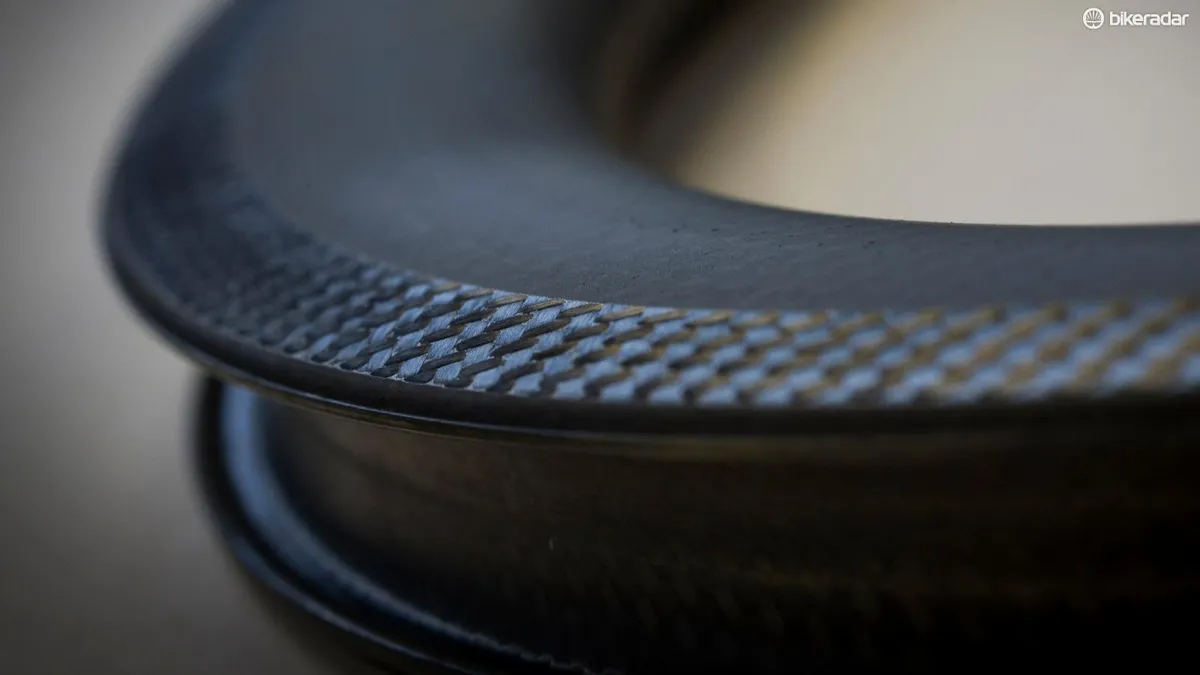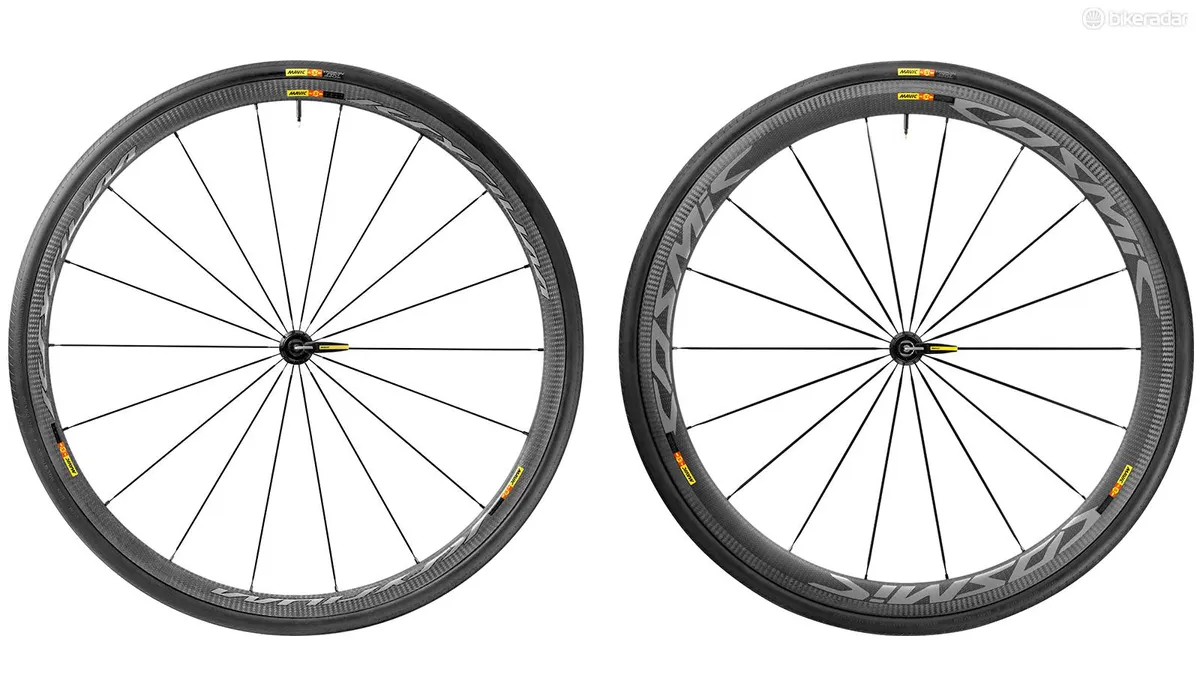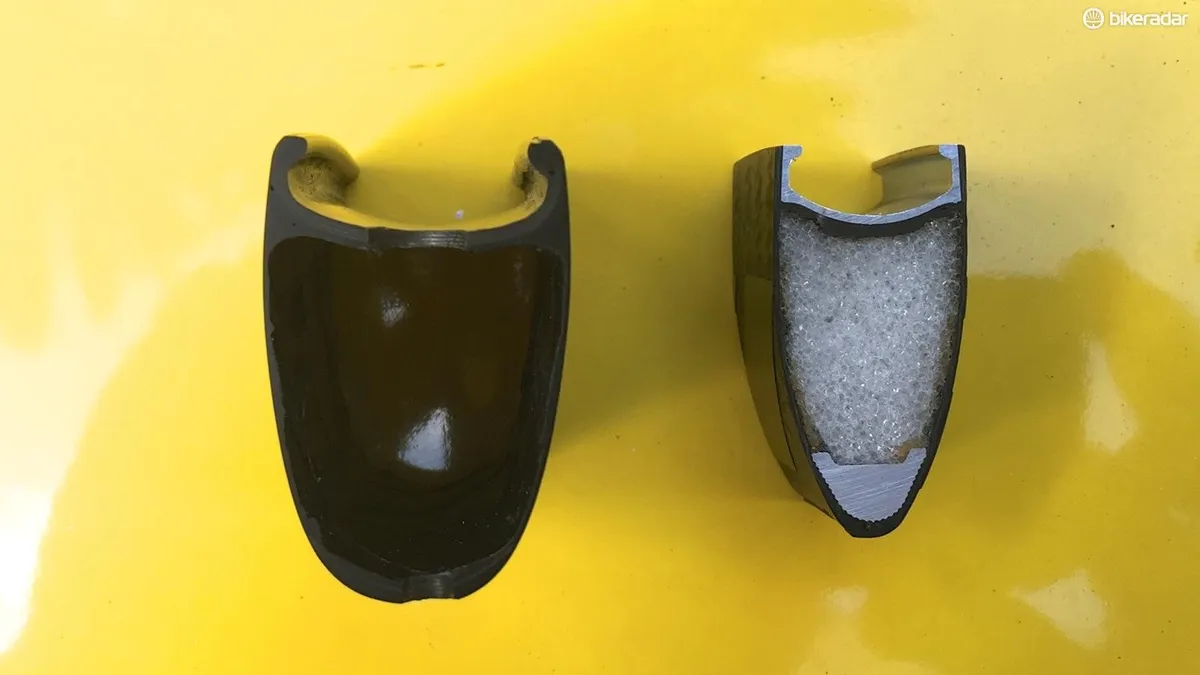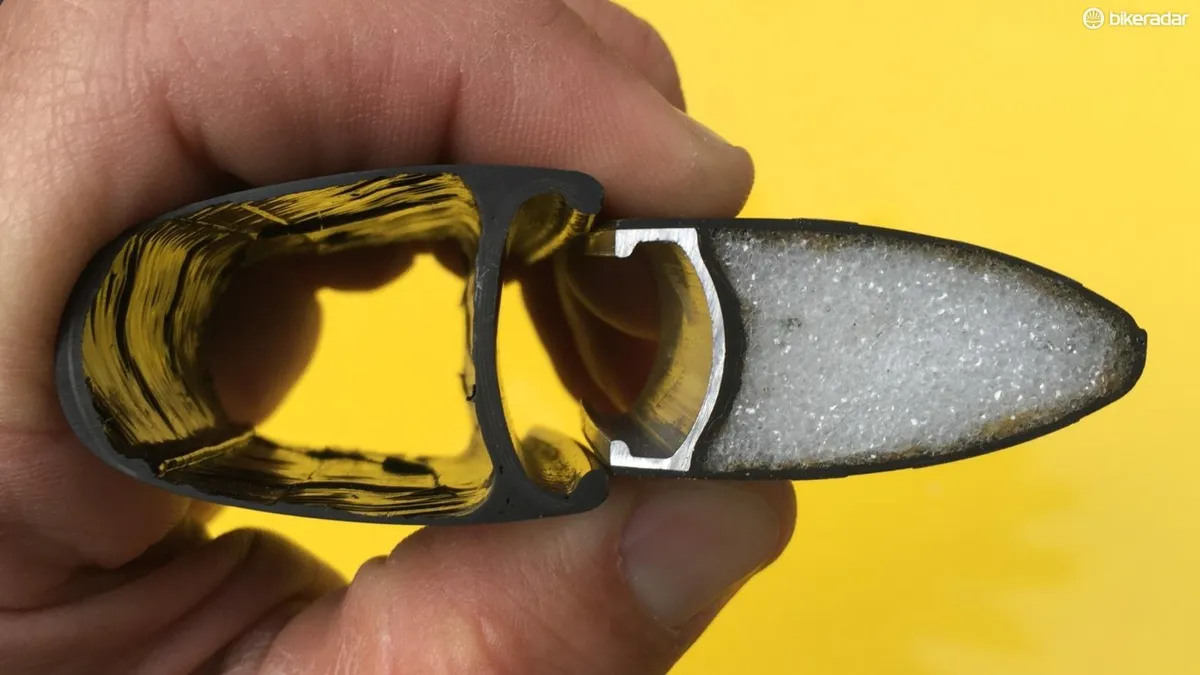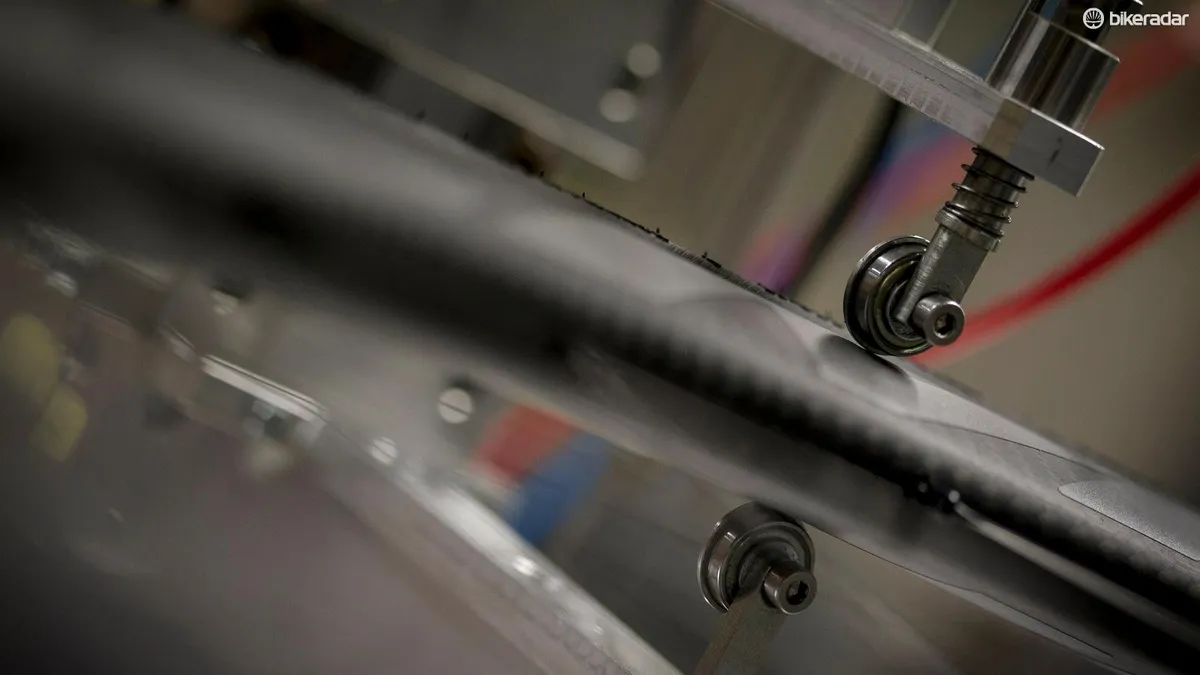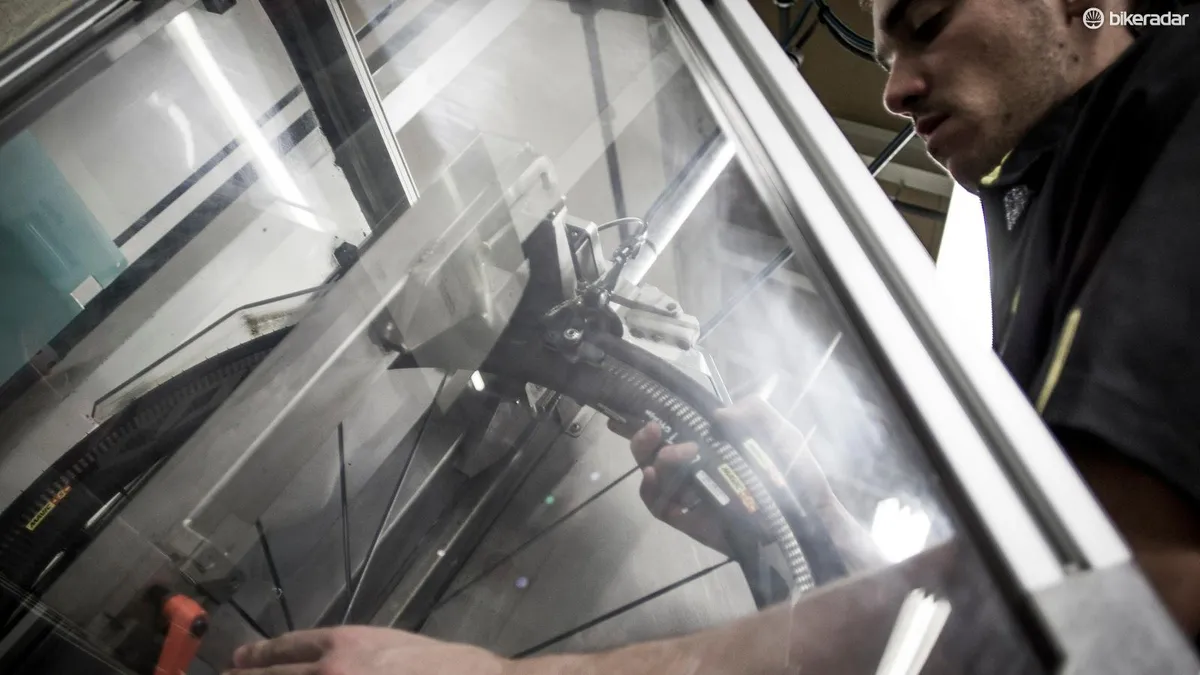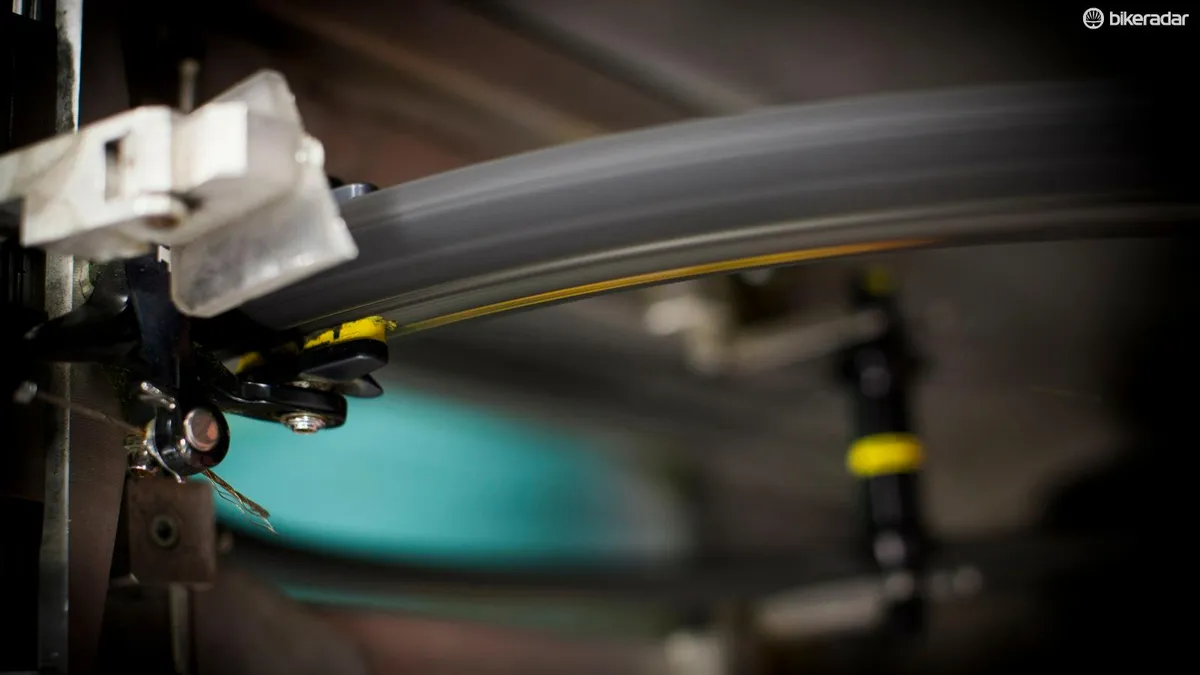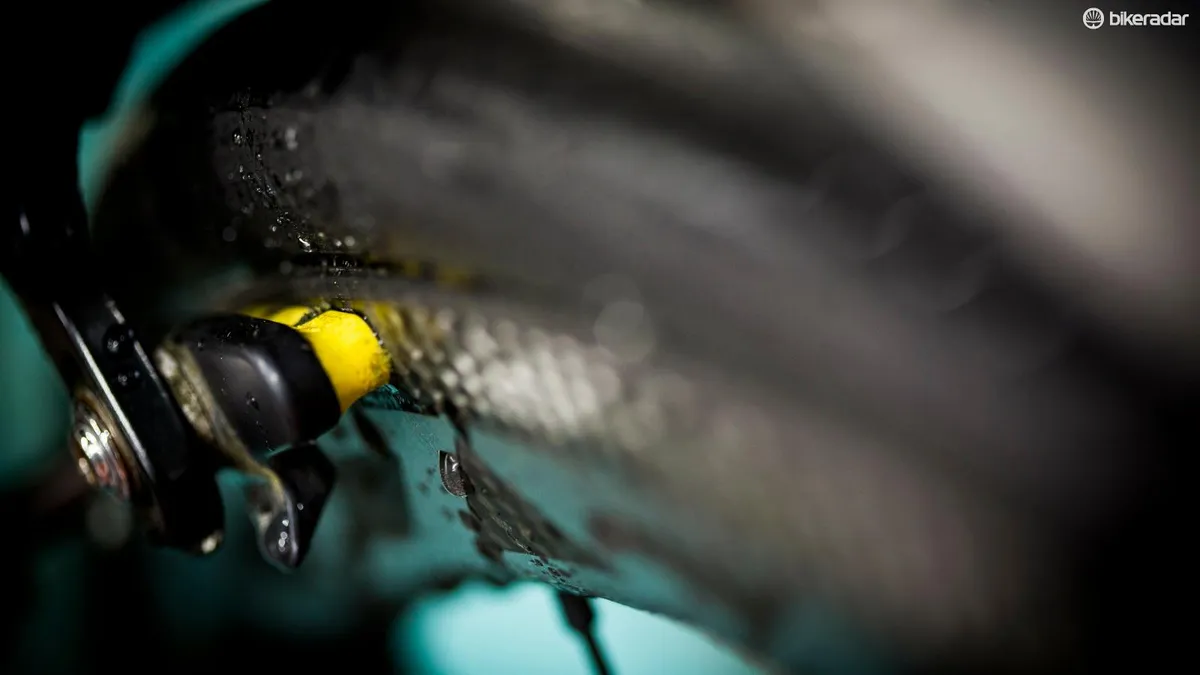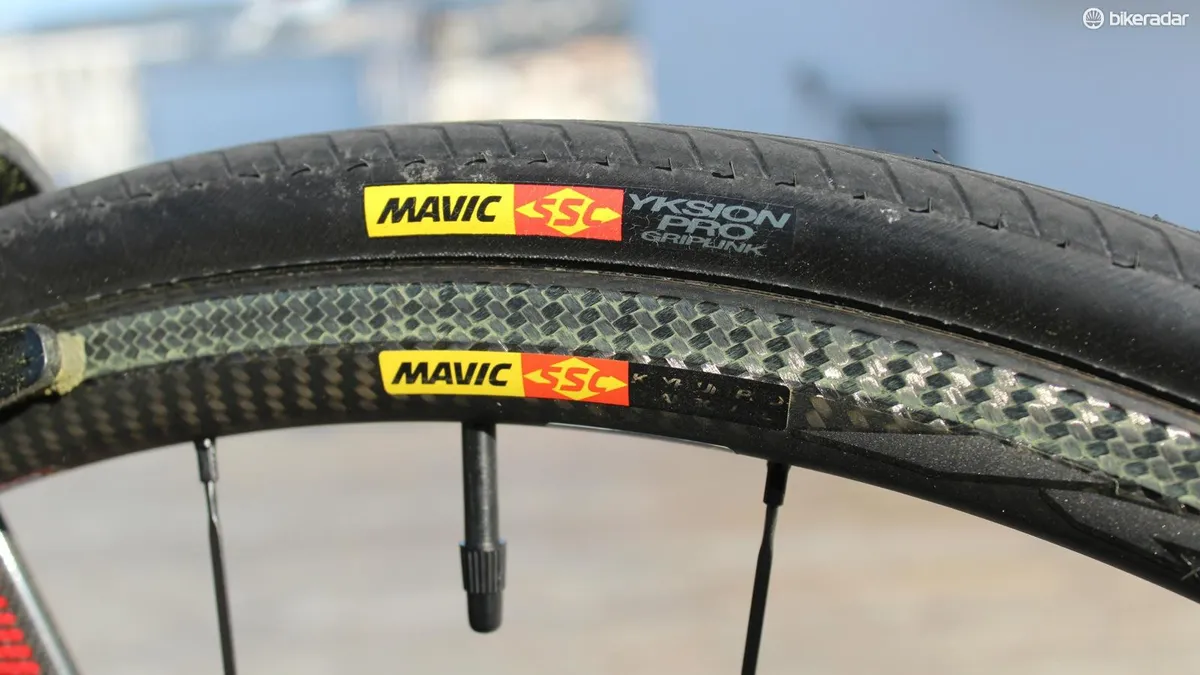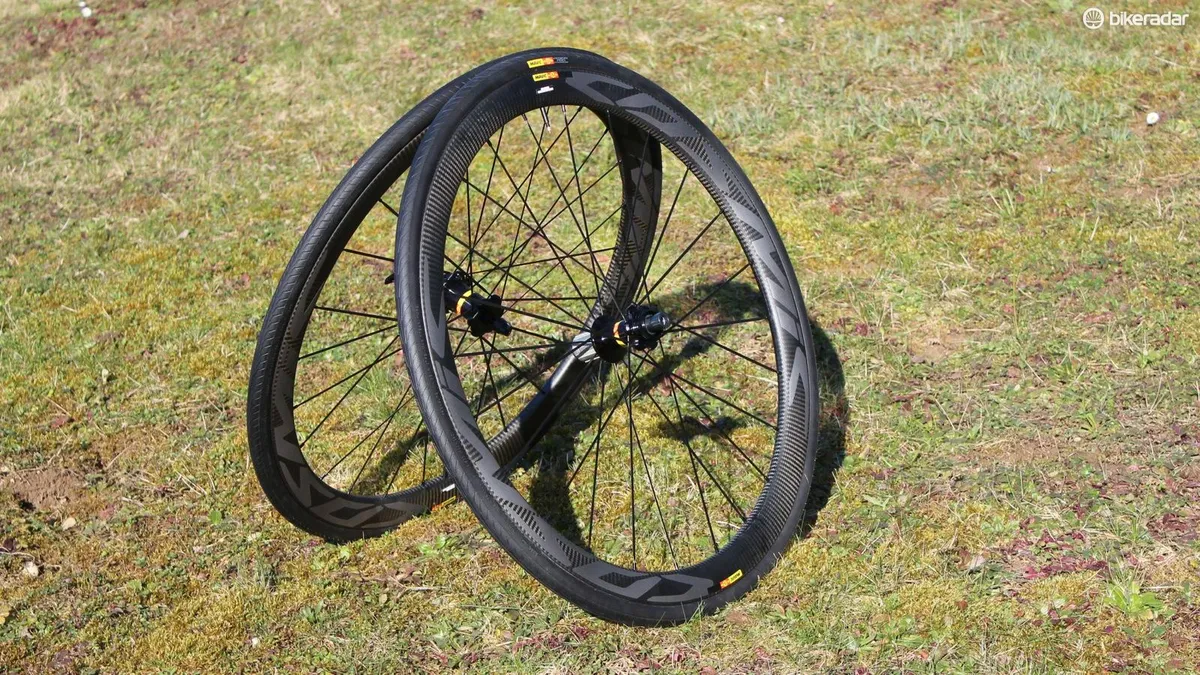With its new Ksyrium Pro Carbon SL C and Cosmic Pro Carbon SL C, Mavic is officially in the full carbon clincher game. What’s more, the French company claims that the new wheels’ wet-weather braking is superior to anything on the market, with aerodynamic performance on the Cosmics that can go head-to-head with the likes of Zipp, Bontrager and Reynolds.
Related: Mavic Ksyrium Pro Carbon SL C first ride review
The 25mm Ksyrium and 40mm Cosmic rims feature a seamless, 17mm-wide carbon rim bed, a laser-machined brake track and a new proprietary epoxy and curing process that allow for temperatures up to 200°C / 393 °F. Mavic also has new hubs for these wheels with a 9-degree engagement, 40-tooth dual-ratchet system. The wheels will come in rim-brake and disc-brake models in both clincher and tubular, but not tubeless.
While its competitors like Zipp, Easton and Reynolds have had carbon clinchers for years, these two new wheels — due out in coming months — are the first full-carbon clinchers from Mavic. Its current so-called carbon clinchers, the Cosmic Carbon 40 C wheels, feature an alloy insert inside the rim bed.
(To confuse matters, the 2016 Ksyrium Pro Carbon SL C that was announced last year had the same alloy insert; that wheel never made it to market, as this new carbon rim technology for the 2017 wheels was completed near the same time.)
So why the delay to all-carbon clinchers? If Mavic could give a one-word answer, it would be ‘safety’. From company president Bernand Millaud on down, Mavic staffers insist that making sure the technology is reliable is more important than rushing to market.
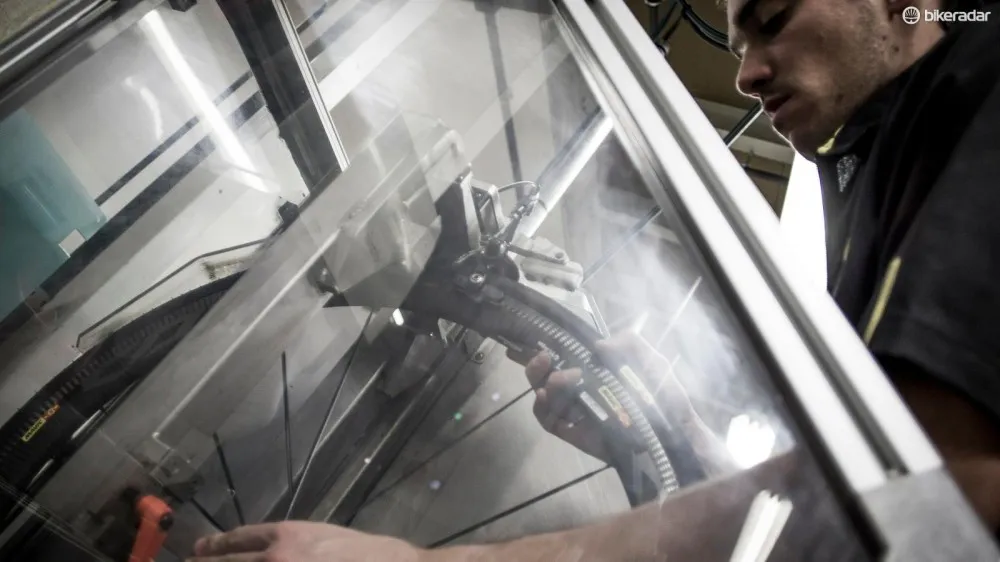
Mavic replicates the braking forces of a 100kg load coming down Mont Ventoux in its in-house testing
As a category, carbon clinchers have had notable failures, with braking heat causing epoxy to soften and rims to deform. In safe failures, this results in a bulge in the rim. In worse instances, it causes the tire to blow off the rim as the bead/hook junction is compromised.
As the longest-running neutral race support operation in the world, Mavic is in a unique position as a wheel company. Its technicians have seen first-hand the results of when imperfect carbon design or execution meets real-world conditions. At the 2015 Etape du Tour, for example, Mavic assisted with 100 wheels, of which 52 were failures and 38 were carbon clinchers that had delaminated, product manager Maxime Brunand said.
New rim materials, curing process and width
Mavic is big on adhering to ISO standards. The 17mm internal width, for instance, is ISO’s maximum allowance for 25mm tires. Anything wider than 17mm is unsafe, ISO and thus Mavic contend.
For the rim hooks, getting the shape exactly right is key for sound tire engagement, Brunand said.
“To get to the proper ISO shape, most carbon wheel makers can do two things: they machine the rim, potentially damaging fibers, or they do nothing, and are potentially outside the spec,” he said, adding that molding carbon into the tight shape can be a challenging process.
While Mavic’s old solution was an alloy insert to fit this shape exactly (as well as handle braking heat), the new solution is a seamless band of carbon, the full width and diameter of the rim.
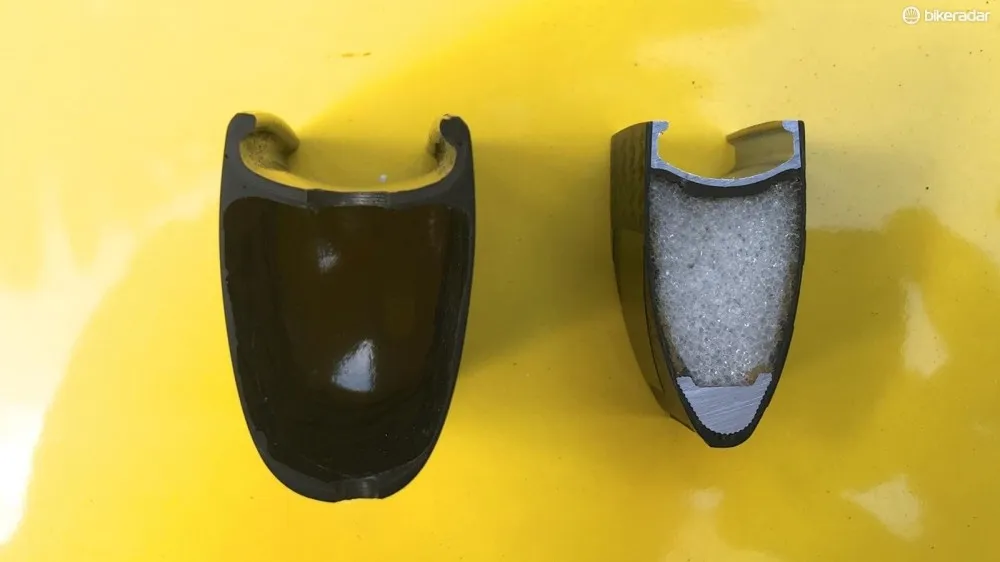
The new rim is a huge leap in width and construction from the previous clincher, the CC40
Brunand declined to elaborate on the process, simply saying the curing process and the resins are proprietary, and that “it is not done by anyone else.”
“Most rims on the market will delaminate before 200C, and extreme braking forces can generate 200C,” Brunand said.
To replicate extreme braking, Mavic's engineers measured the forces of a rider with a heavy backpack coming down Mont Ventoux, and recreated that in their lab with a 100kg load.
The 17mm internal width is a jump forward from the CC40, which was an old-school 13mm.
The wheels are not tubeless. In an extension of the company philosophy of reliability, Brunand said they want to wait to ensure it is done properly. The company’s Ksyrium Allroad alloy wheels are tubeless.
Laser-machined brake track
Last year BikeRadar tested what was supposed to be the new Ksyrium Pro Carbon SL clincher and the tubular version in Jackson Hole, Wyoming. The tubular used a then-new laser-machining treatment that burns resin off the surface of the brake track, leaving it flat and devoid of any substance that could change in consistency with the application of braking heat. As you can read in our review from last summer, the braking performance in the mountains really impressed us.
Mavic has carried this laser machining over to the new wheels. Further, it tests each carbon wheel for evenness of the brake surface, with no more than 0.15mm of variance tolerated.
Mavic has 49 lab tests in all. One involves the Mont Ventoux heavy-braking descent replication, done in the wet and the dry. Using this test, Mavic claims that its wheels offer a shorter stopping distance in the wet than any other carbon clincher.
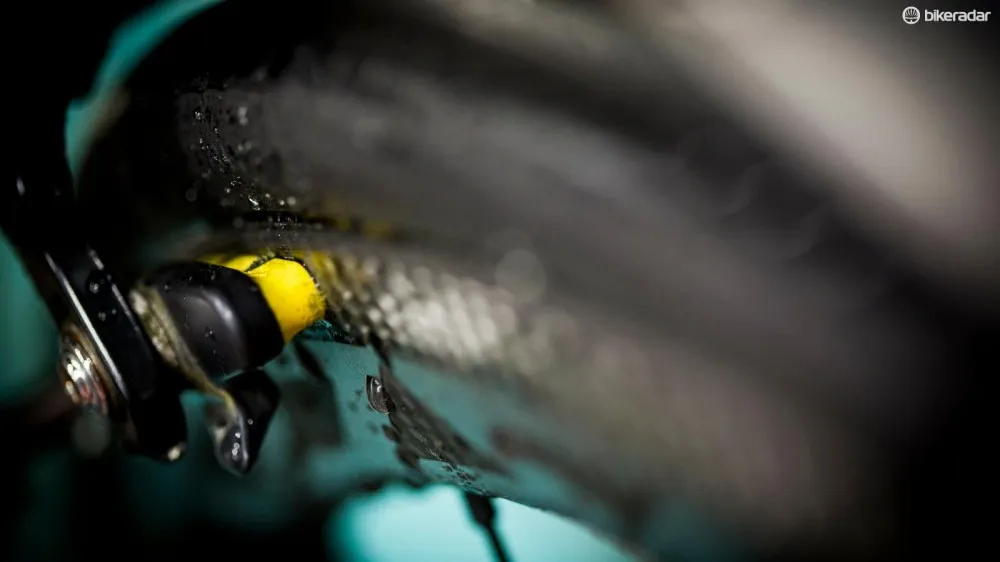
The new rim's braking distance in the wet trumps all carbon clincher competitors, Mavic claims
Faster-engaging hub, for quick release or thru axle, rim or disc brake
Dubbed ‘Instant Drive 360’, Mavic’s new hub isn’t quite instant but it is quick, as a dual-ratchet system with 40 teeth engages every 9 degrees. This means that as you coast, you only have to pedal slightly before the hub engages. The previous system was 12 degrees.
The wheels can work with quick-release and thru-axle frames, thanks to an interchangeable set of end caps.
Further, both the Ksyrium and Cosmic will come in traditional rim-brake and disc-brake models.
Ksyrium Pro Carbon SL C
The 25mm rim of the Ksyrium Pro Carbon SL C weighs 400g. The rim-brake wheelset weighs a claimed 1,390g and comes with Mavic’s 25mm Yksion Pro GripLink rubber up front and PowerLink at the rear, weighing a claimed 210g each.
Bladed steel spokes are laced 18 front and 24 rear with alloy nipples.
The clincher will be available in June for $2,199 / £1,500 / €1,990 for the rim brake and $2,199 / £1,575 / €2,100 for the disc model. The tubular is already available.
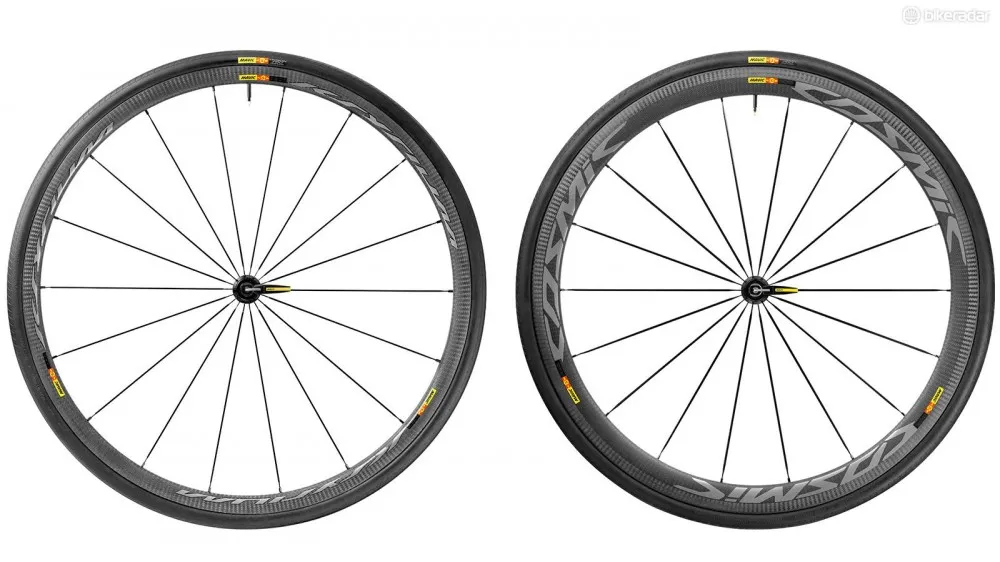
The 25mm Ksyrium Pro Carbon SL at left and the 40mm Cosmic Pro Carbon SL at right
Cosmic Pro Carbon SL
The new 40mm Cosmic is faster than wheels of similar depth from Reynolds and Zipp, and 0.4 watts on average slower than a similar Bontrager averaged across all yaw angles, Mavic claims.
Part of the aerodynamic gain comes from the NACA profile. Although 25mm at the brake track, the Cosmic bulges to 26mm just below for smoother airflow coming off the tire. The Cosmic also uses elliptical spokes, “which is why it competes aerodynamically with 50mm wheels,” Brunand said.
The clincher will be available beginning March 15 in France, the UK and the US, with the rest of the world seeing wheels in May. Suggested retail is $2,199 / £1,450 / €1,990 for the rim-brake and $2,199 / £1,500 / €2,100 for the disc model.
The rim-brake tubular will go on sale in for July $2,399 / £1,575 / €2,100 The tubular disc is already available.
Test program
Mavic is eager to get riders on their wheels, and a free 'Riding is Believing' test program will kick off soon with approximately 1,500 dealers around the world.
You can find a list of participating dealers and register at Mavic's site. It’s free, and just requires feedback via an online form. The program will start with the Cosmic Pro Carbon SL clincher and disc wheels, and will expand to more models.
If you do buy, Mavic will be updating its MP3 insurance program to Mavic Care Plus, which is good for three years of warranty coverage and a crash replacement program for carbon products that gets you 40% off retail.
